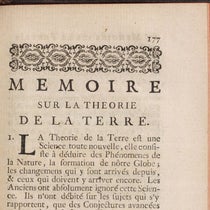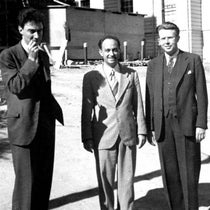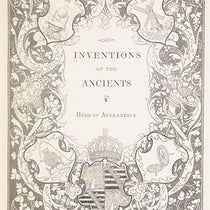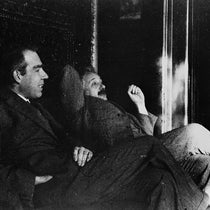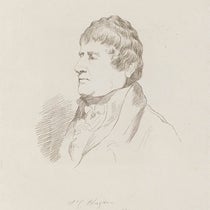Scientist of the Day - David Hilbert
David Hilbert, a German mathematician was born on Jan. 23, 1862, probably in Königsberg, which was then part of Prussia. He attended the Albertina, the University of Königsberg. There he met Hermann Minkowski, who would become his best friend, and remain so as long as they both lived. Hilbert received his doctorate in 1885 and taught at Königsberg until 1895, when he was invited to a professorship of mathematics at the University of Göttingen. He accepted, and would teach at Göttingen until his death in 1943. During his tenue, Göttingen became the preeminent center for mathematics in Europe, if not the world. Unfortunately, in 1933, Hitler mandated the removal of all Jews from university positions, and the department at Göttingen was effectively gutted, with only Hilbert remaining. Since he also suffered from pernicious anemia in his last decades, the twilight of Hilbert’s life was not a happy time.
Since most of the world (including me) has no idea what mathematicians do, and remain unenlightened even when told, we will not attempt to discuss any of Hilbert’s achievements, except for his famous 23 problems. Basically, mathematicians solve problems, and they have been doing so since well before the time of Pythagoras and Euclid. However, not all problems can be solved, at least not right away. Most people have heard of Fermat’s last theorem, referring to a note that Pierre Fermat jotted in a margin, observing that while you can find two square numbers (9 and 16, for example) that add up to third square number (25), there are no pairs of cubic numbers (27 and 64, for example) that add up to a cube (91 is not a cube), nor is it possible with any exponents higher than 2. Proving that conjecture is a problem, and although Fermat claimed that he had a solution to the problem, he died before revealing it, and no one else could prove it. So this was an unsolved problem.
In August of 1900, Hilbert was invited to address the Second International Congress of Mathematicians, meeting at the Sorbonne in Paris. For the occasion, he came up with a list of 23 problems, all of them unsolved, with which he proposed to engage a new century of mathematicians. He only had time to talk about 10 of them in his remarks, but he soon published all 23, in German, and that paper was translated into English and published in the Bulletin of the American Mathematical Society in 1902, which we drew upon for two of our images here. Interestingly, the two most famous unsolved problems of the day, Fermat’s Last Theorem and the Four-Color Problem, were not on the List of 23, although Hilbert mentioned them both in his talk. Hilbert’s 23 Problems became better and better known as the 20th century progressed, since most of the problems were attacked by younger mathmagicians, and some of them were solved, bringing fame to the solver, and usually leading to the founding of a new branch of mathematics.
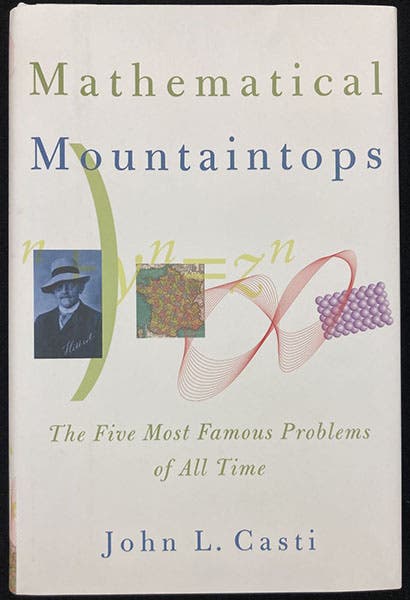
Dust jacket, Mathematical Mountaintops: The Five Most Famous Problems of All Time, by John L. Casti, Oxford, 2001 (author’s copy)
I show a detail of the translated version of Hilbert’s tenth problem, for two reasons (third image). One, it is very short, just a brief paragraph, asking if it can be determined whether a Diophantine equation is solvable or not (a Diophantine equation is one where the coefficients are integers and so are the solutions – the Pythagorean equation for a right triangle is a Diophantine equation). The other reason is to call your attention to a book: Mathematical Mountaintops: The Five Most Famous Problems of All Time, by John L. Casti (Oxford Univ. Pr., 2001). The first chapter is: “Hilbert’s Tenth Problem,” providing you with 30 pages of explanation and explication of just one of Hilbert’s 23 problems. I recommend it, if you wish to know why mathematicians like to solve problems, and why certain problems really excite them. The dust jacket (fourth image) has Hilbert’s portrait at left. And if you want to learn about the Four-Color Problem, turn to chapter 2.
Hilbert died on Feb.14, 1943, and was buried in the city cemetery in Gottingen; he selected for his tombstone his response to the skeptic’s adage: “we know nothing and will never know anything”; Hilbert’s version: Wir müssen Wissen/ Wir werden Wissen – We must know/ We shall know (fifth image).
As a postscript, we wrote a post last week on Hugo Steinhaus, a mathematician who loved problems and wrote books of problems. It is not surprising that Steinhaus received his PhD in 1911, at Göttingen, with David Hilbert as his thesis advisor.
William B. Ashworth, Jr., Consultant for the History of Science, Linda Hall Library and Associate Professor emeritus, Department of History, University of Missouri-Kansas City. Comments or corrections are welcome; please direct to ashworthw@umkc.edu.






